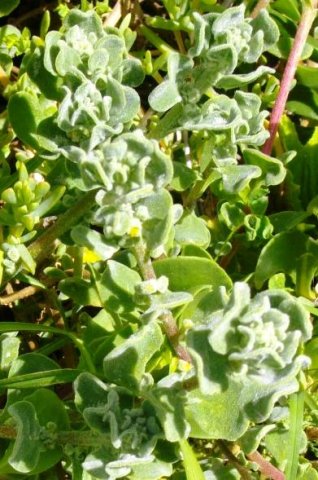Tetragonia decumbens

Tetragonia decumbens, sea spinach or kinkelbos in Afrikaans, is a sprawling perennial sub-shrub that grows on coastal dunes from Namibia to the Eastern Cape.
The trailing branches may become longer than 1 m. The leaves are alternate, succulent and obovate with entire margins. They vary much in size, from 1 cm to 6 cm long and 0,5 cm to 3,5 cm wide. Surface cells on its leaves glisten in the sun. This is the case for the many so-called ice-plants of the Aizoaceae family. The flowers occurring in clusters of 3 to 5 are small with four yellow sepals around the bunched stamens. There are no petals. The fruit is initially green and succulent with four wings, giving rise to the genus name: Tetragonia means four-angled.
The plant is edible. Young leaves and branch tips are cooked with Oxalis pes-caprae, another common plant in the Western Cape. Another edible member of the genus is found in New Zealand. T. tetragonioides, a leafy summer vegetable, commonly known as New Zealand spinach, considered to be the most well-known member of the genus.
Sea spinach is an important ecological component for the coastal dunes. Its capacity as pioneering vegetation and dune stabilization makes it valuable. The organic material it sheds during its life and afterwards, presents the foothold for other plants to follow and bring variety to the beach end of the fynbos (Manning, 2007; Wikipedia; www.plantzafrica.com).

